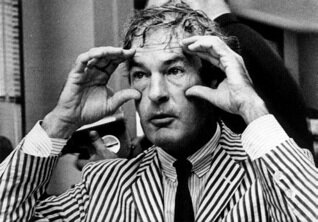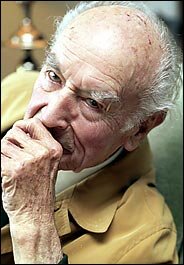Wed 31 May 2006

“The real war is between those who are turned on, and those who are uptight.” -Timothy Leary (October 22, 1920 - May 31, 1996)
Wed 31 May 2006

“The real war is between those who are turned on, and those who are uptight.” -Timothy Leary (October 22, 1920 - May 31, 1996)
Sun 8 Jan 2006
 “LSD spoke to me. He came to me and said, ‘You must find me.’ He told me, ‘Don’t give me to the pharmacologist.’” - ALBERT HOFMANN
“LSD spoke to me. He came to me and said, ‘You must find me.’ He told me, ‘Don’t give me to the pharmacologist.’” - ALBERT HOFMANN
(Photo by Marc Latzel/Lookat)
CRAIG S. SMITH in BURG, Switzerland, The New Yoek Times, reports:
ALBERT Hofmann, the father of LSD, walked slowly across the small corner office of his modernist home on a grassy Alpine hilltop here, hoping to show a visitor the vista that sweeps before him on clear days. But outside there was only a white blanket of fog hanging just beyond the crest of the hill. He picked up a photograph of the view on his desk instead, left there perhaps to convince visitors of what really lies beyond the windowpane.
Mr. Hofmann will turn 100 on Wednesday, a milestone to be marked by a symposium in nearby Basel on the chemical compound that he discovered and that famously unlocked the Blakean doors of perception, altering consciousnesses around the world. As the years accumulate behind him, Mr. Hofmann’s conversation turns ever more insistently around one theme: man’s oneness with nature and the dangers of an increasing inattention to that fact.
“It’s very, very dangerous to lose contact with living nature,” he said, listing to the right in a green armchair that looked out over frost-dusted fields and snow-laced trees. A glass pitcher held a bouquet of roses on the coffee table before him. “In the big cities, there are people who have never seen living nature, all things are products of humans,” he said. “The bigger the town, the less they see and understand nature.” And, yes, he said, LSD, which he calls his “problem child,” could help reconnect people to the universe.
(more…)
Fri 25 Nov 2005
Reuters Health, via Rense.com, reports:
NEW YORK (Reuters Health) - The number of U.S. children and teens who were diagnosed with depression more than doubled between 1995 and 2002, while the use of antidepressant drugs rose and the use of psychotherapy or counseling declined.
The findings, say researchers, point to possible instances of inappropriate prescribing to children.
While guidelines call for children to be treated with either mental health counseling or a combination of counseling and medication, the study found a trend of antidepressants replacing talk therapy.
In addition, although only one antidepressant, Prozac (fluoxetine), has been specifically approved for patients younger than 18, prescriptions for other antidepressants rose after 1995 as well — with children receiving prescriptions for them on an “off-label” basis.
“These trends raise concerns regarding the widespread off-label use of antidepressants lacking reliable evidence of safety and efficacy for use in children and adolescents,” the study authors report in the Journal of Adolescent Health.
(more…)
Wed 16 Nov 2005
The Electric New Paper (SG), via BoingBoing, reports:
THEY say that love is a drug.
But all it took was a kiss for a businessman in Thailand to be knocked out.
That kiss - with a transvestite - turned out to be just a ruse by a gang to drug and rob him.
The Bangladeshi businessman ended up losing more than 300,000 baht ($12,426) worth of cash and valuables earlier this month.
His holiday inamorata? A member of a transvestite gang whose mode of operation was to hide strong sedative pills under their tongues and spit them down the throats of their victims during
a kiss.
They would rob their victims when they passed out.
(more…)
Fri 4 Nov 2005
Michael Kunzelman, Associated Press Writer, reports:
BOSTON –For John Halpern to study the effects of peyote on American Indians who use the hallucinogenic cactus in religious ceremonies, observing from a distance was not an option.
Halpern lived on the Navajo Nation reservation for months at a time and participated in prayer ceremonies. Earning their trust and cooperation would have been impossible if he refused to ingest peyote, he said.
“It never would have happened if I hadn’t done that. It’s one of the ways they take the measure of a man,” said Halpern, a psychiatrist at the Harvard-affiliated McLean Hospital in Belmont, just outside of Boston.
A 1994 federal law allows roughly 300,000 members of the Native American Church to use peyote as a religious sacrament, but Halpern set out to find scientific proof for the Navajos’ belief that the substance is not hazardous to their health.
After five years of research, Halpern and other McLean researchers did not find any evidence of brain damage or psychological problems in church members who frequently use peyote, which contains the hallucinogen mescaline.
In fact, they found that members of the Native American Church performed better on some of the neuropsychological tests than other Navajos who do not regularly use peyote.
(more…)
Wed 2 Nov 2005
JON SARCHE, ASSOCIATED PRESS WRITER, reports:
DENVER — Residents of the Mile High City have voted to legalize the possession of small amounts of marijuana for adults. Authorities, though, said state possession laws will be applied instead.
With 100 percent of precincts reporting early Wednesday, 54 percent, or 56,001 voters, cast ballots for the ordinance, while 46 percent, or 48,632 voters, voted against it.
Under the measure, residents over 21 years old could possess up to an ounce of marijuana.
“We educated voters about the facts that marijuana is less harmful to the user and society than alcohol,” said Mason Tvert, campaign organizer for SAFER, or Safer Alternatives For Enjoyable Recreation. “To prohibit adults from making the rational, safer choice to use marijuana is bad public policy.”
Bruce Mirken of the Washington, D.C.-based Marijuana Policy Project said he hoped the approval will launch a national trend toward legalizing a drug whose enforcement he said causes more problems than it cures.
(more…)
Sat 30 Jul 2005

Activist Marc Emery lights up a large marijuana cigarette in front of London Ontario Police headquarters on Aug. 26, 2003. Police raided a business run by the head of the B.C. Marijuana party on Friday based on a search warrant requested by the U.S. government, which wants Marc Emery extradited to face charges related to the sale of marijuana seeds on the Internet and by mail. Photo: CP
ROD MICKLEBURGH, The Globe and Mail (Canada), reports:
Vancouver — Marc Emery, Canada’s most prominent pro-marijuana activist, is facing the possibility of life imprisonment in the United States for selling marijuana seeds over the Internet to U.S. customers.
In a stunning development, RCMP officers arrested the self-proclaimed “Prince of Pot” in Halifax yesterday after a U.S. federal grand jury indicted him on charges of conspiracy to distribute marijuana seeds, conspiracy to distribute marijuana and conspiracy to engage in money laundering.
The charges stem from Mr. Emery’s lucrative sale of marijuana seeds, an activity he has carried on from his Vancouver base with minimal legal penalty for 10 years.
“I’ve sold about four million seeds,” the marijuana mogul boasted in a 2002 media interview. “Unlike most other seed dealers, I use my real name and I’m easy to find.”
(more…)
Tue 26 Jul 2005
The Globe and Mail (Canadian Press)reports:
Ottawa — Health Canada is advising men who take drugs for impotence and erectile dysfunction to seek immediate medical attention if they experience vision problems.
Users of Viagra, Cialis and Levitra are at risk of a rare side-effect called nonarteritic anterior ischemic optic neuropathy, or NAION, caused when blood flow to the optic nerve is blocked.
Symptoms include sudden and painless loss of vision in one or both eyes. Those who experience one episode are at greater risk of experiencing a second episode affecting the other eye.
While in some cases the condition may improve over time, it can also be irreversible.
(more…)
Fri 22 Jul 2005
Reuters, via BoingBoing, reports:
Brazilian police arrested 10 people on Thursday accused of selling drugs using Google’s international social networking site Orkut, which is hugely popular in the Latin American country.
“We discovered the drug ring first via authorized phone tapping, and later the investigation included monitoring of their activities on the Internet,” said a duty officer at the Drugs Enforcement Service in the city of Niteroi, just across the bay from Rio de Janeiro.
(more…)
Wed 6 Jul 2005
BBC News reports:
Methamphetamine has overtaken cocaine as the biggest drug problem in rural and small towns in the US, according to a crime survey of 45 states.
A survey of 500 county law enforcement agencies found meth-related arrests had gone up over the past three years.
More than half of the police, sheriff departments and other agencies polled said the highly addictive substance was their biggest drug problem.
Less than 20% singled out cocaine and fewer still pointed to marijuana.
(more…)
Sun 15 May 2005
By Hugh O’Shaughnessy, The Independent (UK), reports:
Washington’s “war on drugs” in Colombia is collapsing in chaos and corruption, and the drug producers are winning. The so-called Plan Colombia, which has cost the US more than $3bn (£1.6bn) in the past five years, is being abandoned, Secretary of State Condoleezza Rice has announced.
Last year, the hugely expensive effort to poison coca bushes - whose leaves are the source of cocaine - by aerial spraying ended in failure. More bushes were flourishing in January this year than in January 2004.
Meanwhile, complaints have multiplied about the damage done by the chemical poisons to the health of humans, especially children, as well as to livestock, fish and the environment.
(more…)
Wed 23 Mar 2005
The Associated Press/ By RAJESH MAHAPATRA, Associated Press Writer (NEW DELHI), via Google News, reports:
MAR. 23 6:08 A.M. ET International aid groups on Wednesday slammed the Indian Parliament’s decision to approve patent legislation that ends the decades-old practice of allowing domestic drug companies to make low-cost copies of expensive Western medicines, saying hundreds of thousands of poor people will be affected.
The changes, expected to become law later this week, stem from India’s membership in the World Trade Organization, which enhances the country’s participation in global trade but requires it to enforce stricter patent rules for its US$5 billion (euro3.8 billion) pharmaceutical industry.
International aid groups said the legislation will curb the supply of cheap generic drugs to impoverished nations, threatening the survival of AIDS and cancer patients there.
Some 50 percent of 700,000 HIV patients taking antiretroviral medicines in Africa, Asia and Latin America rely on low-cost drugs from India. A month’s dose of a generic AIDS drug cocktail costs US$30 (euro22), or 5 percent of similar drugs sold by western producers.
“Because India is one of the world’s biggest producers of generic drugs, this law will have a severe knock-on effect on many developing countries which depend on imported generic drugs from India,” said Samar Verma, regional policy adviser at Oxfam International.
The Paris-based Doctors Without Borders described the Indian move as “the beginning of the end of affordable generics.”
(more…)
Thu 17 Feb 2005
David Adam, (UK) Guardian science correspondent, reports:
American soldiers traumatised by fighting in Iraq and Afghanistan are to be offered the drug ecstasy to help free them of flashbacks and recurring nightmares.
The US food and drug administration has given the go-ahead for the soldiers to be included in an experiment to see if MDMA, the active ingredient in ecstasy, can treat post-traumatic stress disorder.
Scientists behind the trial in South Carolina think the feelings of emotional closeness reported by those taking the drug could help the soldiers talk about their experiences to therapists. Several victims of rape and sexual abuse with post-traumatic stress disorder, for whom existing treatments are ineffective, have been given MDMA since the research began last year.
(more…)
Mon 31 Jan 2005
DRAKE BENNETT, The New York Times, reports:
Alexander Shulgin, Sasha to his friends, lives with his wife, Ann, 30 minutes inland from the San Francisco Bay on a hillside dotted with valley oak, Monterey pine and hallucinogenic cactus. At 79, he stoops a little, but he is still well over six feet tall, with a mane of white hair, a matching beard and a wardrobe that runs toward sandals, slacks and short-sleeved shirts with vaguely ethnic patterns. He lives modestly, drawing income from a small stock portfolio supplemented by his Social Security and the rent that two phone companies pay him to put cell towers on his land. In many respects he might pass for a typical Contra Costa County retiree.
It was an acquaintance of Shulgin’s named Humphry Osmond, a British psychiatrist and researcher into the effects of mescaline and LSD, who coined the word ‘’psychedelic'’ in the late 1950’s for a class of drugs that significantly alter one’s perception of reality. Derived from Greek, the term translates as ‘’mind manifesting'’ and is preferred by those who believe in the curative power of such chemicals. Skeptics tend to call them hallucinogens.
Shulgin is in the former camp. There’s a story he likes to tell about the past 100 years: ‘’At the beginning of the 20th century, there were only two psychedelic compounds known to Western science: cannabis and mescaline. A little over 50 years later — with LSD, psilocybin, psilocin, TMA, several compounds based on DMT and various other isomers — the number was up to almost 20. By 2000, there were well over 200. So you see, the growth is exponential.'’ When I asked him whether that meant that by 2050 we’ll be up to 2,000, he smiled and said, ‘’The way it’s building up now, we may have well over that number.'’
The point is clear enough: the continuing explosion in options for chemical mind-manifestation is as natural as the passage of time. But what Shulgin’s narrative leaves out is the fact that most of this supposedly inexorable diversification took place in a lab in his backyard. For 40 years, working in plain sight of the law and publishing his results, Shulgin has been a one-man psychopharmacological research sector. (Timothy Leary called him one of the century’s most important scientists.) By Shulgin’s own count, he has created nearly 200 psychedelic compounds, among them stimulants, depressants, aphrodisiacs, ‘’empathogens,'’ convulsants, drugs that alter hearing, drugs that slow one’s sense of time, drugs that speed it up, drugs that trigger violent outbursts, drugs that deaden emotion — in short, a veritable lexicon of tactile and emotional experience. And in 1976, Shulgin fished an obscure chemical called MDMA out of the depths of the chemical literature and introduced it to the wider world, where it came to be known as Ecstasy.
(more…)
Thu 27 Jan 2005
Tue 17 Aug 2004
LYNN SWEET, Chicago Sun-Times Washington Bureau Chief, reports:
WASHINGTON — The state of Illinois unveils a program today to make it easier for residents to buy cheaper prescription drugs from Canada, England and Ireland, defying the Bush administration in a popular but illegal move.
“The federal government has failed to act,” Gov. Blagojevich said in a statement. “So it’s time that we do.”
(more…)
Fri 23 Jul 2004
WASHINGTON, DC – DEA Administrator Karen P. Tandy today announced the culmination of “Operation Web Tryp” that resulted in ten arrests and targeted five websites. Operation Web Tryp investigated Internet websites distributing highly dangerous designer drug analogues under the guise of “research chemicals” primarily shipped to the U.S. from China and India. These websites are known to have thousands of customers worldwide. One website operator is known to conduct estimated sales of $20,000 per week, while another is known to have been in business for more than five years. These websites sold substances that led to the fatal overdose of at least two individuals and 14 non-fatal overdoses.
(more…)
Thu 3 Jun 2004
Paulo Amorim, The Associated Press (via MSNBC) reports:
Former Beatle says he used cocaine during ‘Pepper’ sessions
Paul McCartney said the Beatles’ song “Got to Get You Into My Life” was directly about marijuana.
LONDON - Paul McCartney says he got no thrill from heroin, but found cocaine more to his liking for a time.
(more…)
Wed 5 May 2004
CHICAGO Habitual marijuana use increased among U.S. adults over the past decade, particularly among young minorities and baby boomers, government figures show.
The prevalence of marijuana abuse or dependence climbed from 1.2 percent of adults in 1991-92 to 1.5 percent in 2001-02, or an estimated 3 million adults 18 and over.
That represents an increase of 800,000 people, according to data from two nationally representative surveys that each queried more than 40,000 adults.
Among 18- to 29-year-olds, the rate or abuse or dependence remained stable among whites but surged by about 220 percent among black men and women, to 4.5 percent of that population, and by almost 150 percent among Hispanic men, to 4.7 percent.
Among all adults ages 45 to 64, the rate increased by 355 percent, to about 0.4 percent of that population.
[..] Overall use of the drug — that is, casual use and habitual use — remained stable at around 4 percent of adults. [..]
(more…)
Wed 5 May 2004

OMAHA, Neb. — A large anhydrous ammonia tank helped Sarpy County Sheriff’s deputies bust a suspected methamphetamine lab Tuesday night.
Anhydrous is the key ingredient in meth, and officers spotted a 9,600-gallon tank in front of a house at 151st and Chandler streets. The owners had run a hose from the tank inside the house, according to deputies.
Several arrests were made. No further information was immediately available.
(more…)
Thu 8 Apr 2004

Seized Pill Stamps that were used to impress designs and logos onto Ecstasy tablets marketed in cities across the U.S.
U.S. Drug Enforcement Administration reports:
March 31 - More than 130 people were arrested today in a two-nation crackdown on a huge drug trafficking ring that manufactured large quantities of Ecstasy and marijuana in Canada and then shipped them to cities around the United States.
One outcome of this three-year investigation, called Operation Candy Box, was the discovery that Ecstasy trafficking, which had largely been controlled by Russian and Israeli gangs, had now spread to groups with ties to Southeast Asia. The two principal targets of this investigation were Ze Wai Wong, a Chinese national, and Mai Phuong Le, a Vietnamese national.
(more…)
Mon 8 Mar 2004
Rick Weiss, Washington Post Staff Writer, Reports:
Capping a 17-year effort by a small but committed group of activists, the federal Drug Enforcement Administration has agreed to let a South Carolina physician treat 12 trauma victims with the illegal street drug ecstasy in what will be the first U.S.-approved study of the recreational drug’s therapeutic potential.
(more…)